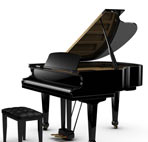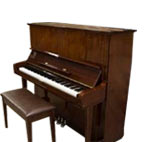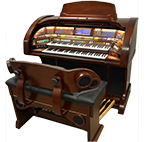Welcome to part two of our piano myths and misconceptions. We’ll cover piano hand technique, questions about improvisation and effective practice strategies in this article. Be sure to check out part one of our piano myths to see common misconceptions about starting piano lessons and practice time.
“I should never look at my hands when I play.”
Reality: Concert pianists MEMORIZE the music and, of course, LOOK AT THEIR HANDS! It absolutely mystifies me why the average piano teacher indoctrinates students into not looking at their hands. It is so unprofessional and unnatural to strive to not look at one’s hands. The only time this is useful is LATER, when the student becomes a proficient sight-reader, it is certainly convenient to not need to look down at one’s hands so often because it allows one to look ahead, which enhances sight-reading. BUT… this is just a small aspect of the full world of piano playing. In striving for this “goal” of not looking down you are limiting EVERY OTHER aspect of piano playing! For example, it is very hard to develop the muscular memory, and therefore the ability to play fast, when your eyes are always glued to the page.
“I must always look ahead when reading music.”
Reality: You’ve heard this your whole musical life. But the reality is that only after you’ve mastered the art of tactile sensitivity — of being able to easily find any note on the piano keyboard without looking at it, from having done various keyboard orientation drills — that this would be true. Otherwise, to look ahead is virtually impossible. This is because when you look at a note on the score, you then need to look down to your hands in order to play it. When you look back up to the score, if you attempt to look ahead YOU WILL GET LOST! This will happen with each note read! This is because when you look back up to the score you don’t know what the next note is. What is more efficient is to purposely look back at the note(s) you JUST PLAYED and then quickly move your eyes to the next note. It’s easy to remember which note you just played because you just saw it and it is very familiar in your mind. By looking back to the score for THIS note, after having looked down at your hands, you will never get lost.
“Forcing a child to study piano is for their own good and they will appreciate it later.”
Reality: For the small percentage of people for whom this may be true, there is a much higher percentage of people who end up permanently pulling away from music! I can verify this as most of my students are adults and many of these are “returnees.” These are people who quit the piano for 35 years because they were traumatized as kids, being forced to play in recitals that they were not prepared for, or to take endless lessons that they hated. These are people who, as a result, overcompensated by having NO music in their life at all! These broken souls need a lot of encouragement and healing and love. They can definitely become confident musicians in the long run, but it is very hard work at that point, because the trauma often cuts so deeply into their consciousness. If I detect that a child does not like the piano, then I will inform the parents that I cannot be his or her teacher, because I do not want to perpetuate such a cycle.
“Once I can play hands together, I don’t need to continue practicing hands separately.”
Reality: The very steps that bring you to a certain level of mastery are the ones that will help to maintain that level of mastery. Most people assume that practicing hands separately is a temporary step towards the goal of playing hands together. But let’s examine what professionals do. They will continue to practice hands separately on a piece they’ve played for 25 years! This is because only when you practice hands separately can you really focus on certain nuances that would be obscured if you were spreading your focus between two hands. The better hands are mastered separately, the more reliable and proficient it will be when you then bring hands back together. So, please think of practicing hands separately not only as an initial phase of learning a passage, but also as a way to MAINTAIN and also to further improve and polish a section of a piece you’re working on.
“If something seems too easy at the piano, I must be doing it wrong.”
Reality: If something seems too easy at the piano, it means you’re doing it RIGHT! Our society places such a value on “no pain, no gain.” But in the area of piano study, if you have pain, it is an indication that you are doing something WRONG. You could be over-stressing the muscles. You could be at a wrong height, wrong distance, wrong angle, wrong pressure, etc. There are so many things to consider regarding piano technique. Experiencing pain is a warning that you must STOP immediately and find another way. Pain is your clue that you are on the way to developing carpal tunnel syndrome or tendinitis or other injuries.
“I could never be a great pianist if I don’t have long, slender fingers.”
Reality: Great pianists come in all shapes and sizes. There is no preference for long slender fingers. In fact, if there were a preference, it would be tapered fingers. These are fingers that are thick and muscular at the point where they connect to the hand, but become thinner towards the tips. This allows the fingers to have strength yet can also easily fit between the black notes, when necessary. In fact, comments I’ve often heard from people who have the fabled long, slender fingers are that they make MORE mistakes, their fingers get “tied up in knots,” and that they are more prone to carpal tunnel injury!
“Improvisation is something I will only be able to do in the future, after I understand theory better.”
Reality: Start now. Don’t be limited by what is normally thought of as “jazz improvisation.” This type of improvisation is what I call “mental improvisation.” In order to do this type of improvisation, you must use your mind to be aware of chord changes and understand various scales and notes that correspond to the current chord. But there are other types of improvisation. There is “emotional improvisation” and “spiritual improvisation.” Emotional improvisation is when you express your emotions through music. Spiritual improvisation is when you are tuning-in to something bigger than you (“channeling.”) Ironically, in order to do either of these two other types of improvisation you must turn OFF your mind. Therefore they are NOT mental. I find that it is valuable to allow yourself to develop these alternative methods of self-expression concurrently (while) you are studying theory. This is because they will create an intimacy or connection to the keyboard that you ultimately will want. For example, if you studied theory for eight years, you might STILL feel a veil between your fingers and the keyboard. Knowing theory alone will not make you a better improvisor. You also need courage, spontaneity, and freedom to express what you hear in your head instantly. How will you develop this intimacy with the piano? Playing your feelings and tuning-in to something bigger than you, without judgment, a little bit every day, is a wonderful way to develop this comfort level. Eventually, when you do know all the theory you desire, your fingers will be at liberty to execute every musical whim.
“When initially learning piano, it is good training to ‘lift the fingers high with precision.’”
Reality: This dictum from the Hanon finger exercise books and other old-fashioned technique carry-overs causes more problems than anything else. When you train the fingers to raise higher than necessary, you are training them to travel a greater distance than necessary. The key depth is approximately 3/8ths of an inch. If you could let the finger tips rest on the tops of the keys themselves, the only distance required for each finger to travel is 3/8ths of an inch! But many people are misguided into raising their fingers high with each key stroke, so they are compelled to make each finger travel up to THREE and 3/8ths of an inch! This seriously slows down your potential speed and creates much more tension in the playing than necessary.
“My practice session should always begin with finger drills to warm up the hands.”
Reality: Start your practice session with the most difficult activity, while your mind is freshest. Generally, the most mentally taxing aspect of studying piano is learning new repertiore. The assumption that we need to warm up the hands before we work on our pieces is truly misguided. When you first sit at the piano, you are the most alert. It therefore would be more efficient to do the most difficult thing (which is usually learning new notes of a new section of a piece) when you are the freshest mentally. When you become fatigued mentally, say after 20 to 30 minutes, THEN do some finger technique. Then come back and work some more on repertiore. This way, when your mind is tired, you can work your fingers. When your fingers become tired, you can work your mind. This constant alternation of activities when practicing is highly efficient, prevents boredom and enhances the “layering” effect of repetition that is needed to excel both at technique and learning repertoire at maximum speed.
“When practicing, I should never rush.”
Reality: It is PREFERABLE to play any sections of a piece you are learning FASTER than you need! Eventually, when you attach each section to one another, you will be inclined to slow down because it is harder. But you will slow down to the correct speed of the piece. Most people have a very hard time getting the piece up to the right tempo because they practice each section at the right tempo and then when they attach the sections to one another, it becomes TOO SLOW! This commonly-heard advice about not rushing is only applicable AFTER you have learned the piece when one may be tempted to sacrifice accuracy for speed. In that case ONLY would it be true that one should not rush.
“I must not work on any new pieces until I master the one I’ve already started.”
Reality: Professional pianists have 10 or 20 pieces that they are working on concurrently! There are sections within each piece that are at varying levels of mastery. This is really a good way to go about practicing, because if we become fatigued or bored, we become much less efficient with our learning. By giving yourself permission to switch your attention to different compositions or to different sections within one piece, you are actually BECOMING efficient. This happens for two reasons: 1) You are honoring your fatigue level on any one piece. 2) When you step away from working on something, you allow your subconscious to do ITS job and continue processing it without giving it your attention. This dramatically increases the results, better than if you had been exclusively working on the one piece.
“I should learn a new piece in order, from the beginning to the end.”
Reality: The most efficient way to study a composition is to learn the most difficult sections FIRST! Here’s why: The typical way that people learn is to learn the first part first. Then, each day they push forward and learn a few new measures. The problem is that it’s very tempting to stop pushing forward and to prematurely reward yourself by playing through the part you’ve already learned. This, of course, is the beginning section. As you approach the part that you don’t yet know, you hear the music getting slower and sloppier until it just stops. Then, this is so frustrating, you are tempted to repeat the part that you know again rather than work on the new section. So in essence, when you do this, you end up “practicing” the part you already know and avoiding the parts that you don’t yet know. This is so common, yet so ineffective! The worst part of it is that the part you already know is often the easiest portion of the music, as composers rarely start out with the most difficult passages. So think about it: You end up practicing and practicing and practicing the first section of the piece every time you “run through the part you already know.” Yet this is the EASIEST section and requires collectively the LEAST time. Whereas the hardest parts that require the MOST time collective are the parts you tend to avoid each day. It would be so much more efficient if you could get out of the assumption that you should learn the first part first. Instead, scan through the new composition and determine which sections appear to be the most difficult. Start on THESE sections, even if they are not connected. Eventually, each section will grow and they will overlap into each other. NOW, when you want to play through the sections you “already know,” it will be the HARDEST sections that you play through rather than the easiest. This means even if you avoid learning the new sections and you fall back on playing the parts you already have learned, you will still be doing some good, because these sections are the ones that will benefit by the continued review since they are so difficult. In the end, you will have over-practiced the hard sections and under-practiced the easy sections. The result will be that all the sections will be equally-mastered and this is what will help you reach your goal sooner than later!
“If I want to play other instruments, the piano is a good foundation and will make those other instruments easier to learn.”
Realty: This is a serious myth. Some of the best violinists and flutists and cellists and saxophonists NEVER had piano lessons. Learning any instrument will have its challenges. There ARE certain things that are clearer on the piano because the notes are laid out in a linear order, so on certain cases, when you are learning scales or chord theory, it is often easier to understand. However, it does not necessarily make you BETTER on other instruments because you have had piano training first.










